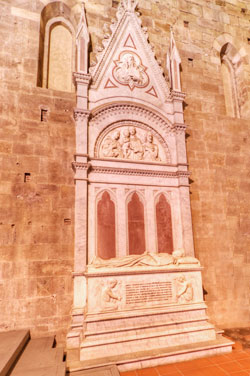Iconografia del Risorgimento a Lucca: l'omaggio a Matilde di Canossa
Romano Silva
La risposta "iconografica" di coloro che a Lucca si riconoscevano nella tradizione cattolica è il cenotafio, scolpito dallo scultore lucchese Vincenzo Consani, di Matilde di Canossa nella chiesa di San Giovanni. Il Consani aveva studiato a Firenze con Luigi Pampaloni e soggiornò a lungo nel capoluogo toscano, dove stabilì il suo atelier, ma rimase strettamente legato alla sua città. Il cenotafio di Matilde di Canossa eretto nella chiesa di San Giovanni era già stato concepito in età preunitaria dallo scultore come celebrazione di un'illustre personaggio storico lucchese. La scelta cadde su Matilde di Canossa, «che se non è certo avesse in Lucca i natali, è però certo che di Lucca fu oriunda e in Lucca assai risiedè e insigni fabbriche vi eresse e sussidiò». Il Consani generosamente intendeva eseguire il monumento a sue spese, ma non riuscì a portarlo a termine e le vicissitudini di questo monumento si protrarranno per quasi un secolo. Vincenzo Consani non apparteneva al partito dei clericali intransigenti come il marchese Lorenzo Bottini, ma senza dubbio, in quanto cattolico, avvertì dolorosamente l'episodio della presa di Roma, come rivela il fatto che la figura di Matilde giacente da inserire nel mausoleo lucchese fu compiuta nel 1872. L'omaggio a Matilde, che donò al papato gran parte dei suoi beni, dopo il 1870 acquisisce un significato così evidente che non ha bisogno di commenti. La marchesa di Tuscia raffigurata defunta sul letto funebre, sul cui bordo si legge un'iscrizione in eleganti caratteri gotici «Mathelda Bonifatii Marchionis Filia Comitissa Tusciae», diviene chiara allusione all'eredità da lei lasciata ai pontefici e "depredata" dai sovrani d'Italia. Nonostante ciò l'iniziativa del Consani riscosse scarso consenso. Al di là delle difficoltà di natura finanziaria, c'era probabilmente anche l'ombra di un avvenimento remoto che trovava riscontro concreto nella situazione politica contemporanea. Matilde di Canossa e sua madre Beatrice avevano preferito Firenze a Lucca come sede ufficiale della marca di Tuscia e troppo recente (1847) era la perdita dell'autonomia a favore del capoluogo toscano perché i lucchesi non avvertissero un collegamento ideale tra i due avvenimenti e di conseguenza una certa inconfessata avversione per la marchesa di Tuscia, che, a dispetto delle sue presunte e sempre meno credibili origini lucchesi, era stata espressione della supremazia di Firenze. Nel 1935 il cenotafio fu finalmente completato a spese della Cassa di Risparmio di Lucca in occasione del centenario della sua fondazione. Alla luce dei Patti Lateranensi del 1929, Matilde fu considerata di nuovo un'eroina e, come recita l'epigrafe collocata in quell'occasione, si «volle qui nuovamente/esaltare il nome della pia e gloriosa donna di Canossa a per/petuo ammonimento ai nemici della patria a illustre conferma/dei vincoli indissolubili che uniscono la Chiesa e l'Italia».
Iconografia del Risorgimento a Lucca: l'omaggio a Matilde di Canossa
Romano Silva
The "iconographical" answer for those in Lucca who identified themselves with catholic tradition is the cenotaph of Matilde of Canossa in the church of San Giovanni, made by Vincenzo Consani, a sculptor from Lucca. Consani had studied in Florence with Luigi Pampaloni. He remained there for a long period and also set up his "atelier" there, but he still kept strong ties with his own town. The sculptor already had plans for the cenotaph of Matilde of Canossa, which is to be found in the church of San Giovanni, before the Unity of Italy, to celebrate an illustrious figure in the history of Lucca. His choice fell on Matilde of Canossa, «who, if it is not certain whether she was born in Lucca, definitely came from Lucca and lived there much and built and subsidised renown factories there». Consani generously intended to accomplish the monument at his own expense, but did not succeed in completing it, and the ups and downs of this cenotaph were to continue for almost a century. Vincenzo Consani did not belong to the party of diehard clericalists like the marquis Lorenzo Bottini, but without doubt, as a catholic, he was distressed by the taking of Rome, as revealed by the fact that the figure of Matilde lying down to be placed in the Lucca mausoleum was completed, as shown by the date, in 1872. The homage to Matilde, who donated a large part of her possessions to the papacy, takes on such a clear significance after 1870 that no comment is necessary. The marquise of Tuscia represented deceased, lying on her death bed, with an inscription in elegant gothic characters on its border «Mathelda Bonifatii Marchionis Filia Comitissa Tuscie», becomes a clear allusion to the inheritance she left to the pontiffs which was "plundered" by the sovereigns of Italy. Despite this, Consani's initiative met with little approval. Besides the difficulties of a financial nature there was probably also the shadow of a remote event which bore a clear comparison with the contemporary political situation. Matilde of Canossa and her mother Beatrice had preferred Florence to Lucca as the official seat for the marquisate of Tuscia and the loss of autonomy in favour of Florence was too recent (1847) for the people of Lucca not to sense an ideal connection between the two events and consequently a certain unacknowledged aversion for the marquise of Tuscia, who, in spite of her presumed and increasingly less credible origins from Lucca, had been the expression of Florentine supremacy. In 1935 the cenotaph was at last completed at the expense of the Cassa di Risparmio di Lucca to mark the centenary of its foundation. In the light of the Lateran Treaty of 1929, Matilde was once again considered a heroine and as the epigraph provided on that occasion states «may the name of the pious and glorious lady of Canossa be here exalted anew in perpetual warning to the enemies of the fatherland in illustrious confirmation of the indissoluble bonds which unite the Church and Italy ».
 DOCUMENTI PDF
DOCUMENTI PDF
L'omaggio a Matilde di Canossa
I MONUMENTI
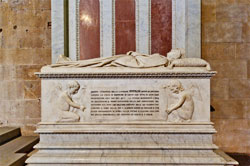
Matilde di Canossa
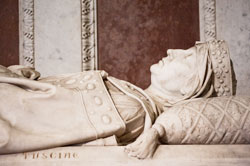
Particolare del monumento
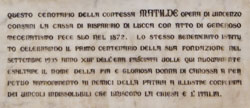
Iscrizione sul cenotafio
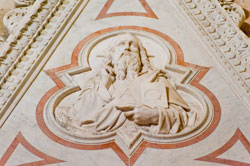
Particolare del timpano


